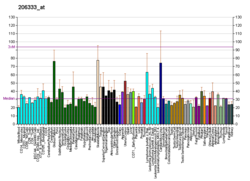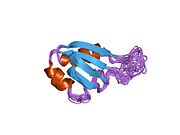Protein-coding gene in the species Homo sapiens
| MSI1 |
|---|
 |
| Available structures |
|---|
| PDB | Ortholog search: PDBe RCSB |
|---|
| List of PDB id codes |
|---|
1UAW, 2MSS, 2MST, 2RS2 |
|
|
| Identifiers |
|---|
| Aliases | MSI1, musashi RNA binding protein 1 |
|---|
| External IDs | OMIM: 603328; MGI: 107376; HomoloGene: 55657; GeneCards: MSI1; OMA:MSI1 - orthologs |
|---|
| Gene location (Human) |
|---|
 | | Chr. | Chromosome 12 (human)[1] |
|---|
| | Band | 12q24.31 | Start | 120,341,330 bp[1] |
|---|
| End | 120,369,164 bp[1] |
|---|
|
| Gene location (Mouse) |
|---|
 | | Chr. | Chromosome 5 (mouse)[2] |
|---|
| | Band | 5|5 F | Start | 115,567,658 bp[2] |
|---|
| End | 115,593,757 bp[2] |
|---|
|
| RNA expression pattern |
|---|
| Bgee | | Human | Mouse (ortholog) |
|---|
| Top expressed in | - ventricular zone
- ganglionic eminence
- frontal pole
- left testis
- right testis
- anterior pituitary
- islet of Langerhans
- amygdala
- cingulate gyrus
- anterior cingulate cortex
|
| | Top expressed in | - neural layer of retina
- ventricular zone
- molar
- epithelium of lens
- Rostral migratory stream
- ganglionic eminence
- tail of embryo
- habenula
- epiblast
- somite
|
| | More reference expression data |
|
|---|
| BioGPS |  | | More reference expression data |
|
|---|
|
| Gene ontology |
|---|
| Molecular function | - single-stranded RNA binding
- nucleic acid binding
- poly(U) RNA binding
- identical protein binding
- RNA binding
| | Cellular component | - cytoplasm
- polysome
- nucleus
- ribonucleoprotein complex
| | Biological process | - nervous system development
| | Sources:Amigo / QuickGO |
|
| Orthologs |
|---|
| Species | Human | Mouse |
|---|
| Entrez | | |
|---|
| Ensembl | | |
|---|
| UniProt | | |
|---|
| RefSeq (mRNA) | | |
|---|
NM_008629
NM_001376960
NM_001376961
NM_001376962
NM_001376963 |
|
|---|
| RefSeq (protein) | | |
|---|
NP_032655
NP_001363889
NP_001363890
NP_001363891
NP_001363892 |
|
|---|
| Location (UCSC) | Chr 12: 120.34 – 120.37 Mb | Chr 5: 115.57 – 115.59 Mb |
|---|
| PubMed search | [3] | [4] |
|---|
|
| Wikidata |
| View/Edit Human | View/Edit Mouse |
|
RNA-binding protein Musashi homolog 1 also known as Musashi-1 is a protein that in humans is encoded by the MSI1 gene.[5][6]
Function
This gene encodes a protein containing two conserved tandem RNA recognition motifs and functions as an RNA binding protein that is involved in post-transcriptional gene editing. It is a stem cell marker that controls the balance between self-renewal and terminal differentiation.[7][6]
Clinical significance
Over expression of this gene is associated with the grade of the malignancy and proliferative activity in gliomas and melanomas.[7] An increased expression of MSI1 protein is observed in endometriosis and endometrial carcinoma[8] siRNA-mediated inhibition of MSI expression in endometrial carcinoma cells induces apoptosis and inhibits cell proliferation by affecting the Notch signaling pathway[9]
MSI1 is highly expressed in neural progenitor cells and is required for normal development of the brain. A mutation in these gene is responsible for autosomal recessive primary microcephaly. MSI1 also interacts with the Zika virus genome and may explain why these cells are highly susceptible to Zika virus infection.[10][11]
See also
References
- ^ a b c GRCh38: Ensembl release 89: ENSG00000135097 – Ensembl, May 2017
- ^ a b c GRCm38: Ensembl release 89: ENSMUSG00000054256 – Ensembl, May 2017
- ^ "Human PubMed Reference:". National Center for Biotechnology Information, U.S. National Library of Medicine.
- ^ "Mouse PubMed Reference:". National Center for Biotechnology Information, U.S. National Library of Medicine.
- ^ Good P, Yoda A, Sakakibara S, Yamamoto A, Imai T, Sawa H, Ikeuchi T, Tsuji S, Satoh H, Okano H (September 1998). "The human Musashi homolog 1 (MSI1) gene encoding the homologue of Musashi/Nrp-1, a neural RNA-binding protein putatively expressed in CNS stem cells and neural progenitor cells". Genomics. 52 (3): 382–4. doi:10.1006/geno.1998.5456. PMID 9790759.
- ^ a b "Entrez Gene: MSI1 musashi homolog 1 (Drosophila)".
- ^ a b Glazer RI, Vo DT, Penalva LO (2012). "Musashi1: an RBP with versatile functions in normal and cancer stem cells". Frontiers in Bioscience. 17 (1): 54–64. doi:10.2741/3915. PMID 22201732.
- ^ Götte M, Wolf M, Staebler A, Buchweitz O, Kelsch R, Schüring AN, Kiesel L (2008). "Increased expression of the adult stem cell marker Musashi-1 in endometriosis and endometrial carcinoma". Journal of Pathology. 215 (3): 317–29. doi:10.1002/path.2364. PMID 18473332. S2CID 206323361.
- ^ Götte M, Greve B, Kelsch R, Müller-Uthoff H, Weiss K, Kharabi Masouleh B, Sibrowski W, Kiesel L, Buchweitz O (2011). "The adult stem cell marker Musashi-1 modulates endometrial carcinoma cell cycle progression and apoptosis via Notch-1 and p21WAF1/CIP1". International Journal of Cancer. 129 (8): 2042–2049. doi:10.1002/ijc.25856. PMID 21165952. S2CID 35338227.
- ^ Chavali PL, Stojic L, Meredith LW, Joseph N, Nahorski MS, Sanford TJ, Sweeney TR, Krishna BA, Hosmillo M, Firth AE, Bayliss R, Marcelis CL, Lindsay S, Goodfellow I, Woods CG, Gergely F (2017). "Neurodevelopmental protein Musashi-1 interacts with the Zika genome and promotes viral replication". Science. 357 (6346): 83–88. Bibcode:2017Sci...357...83C. doi:10.1126/science.aam9243. PMC 5798584. PMID 28572454.
- ^ Griffin DE (2017). "Why are neurons susceptible to Zika virus?". Science. 357 (6346): 33–34. Bibcode:2017Sci...357...33G. doi:10.1126/science.aan8626. PMID 28684491.
Further reading
- Okano H, Imai T, Okabe M (April 2002). "Musashi: a translational regulator of cell fate". Journal of Cell Science. 115 (Pt 7): 1355–9. doi:10.1242/jcs.115.7.1355. PMID 11896183.
- Toda M, Iizuka Y, Yu W, Imai T, Ikeda E, Yoshida K, Kawase T, Kawakami Y, Okano H, Uyemura K (April 2001). "Expression of the neural RNA-binding protein Musashi1 in human gliomas". Glia. 34 (1): 1–7. doi:10.1002/glia.1034. PMID 11284014. S2CID 24208393.
- Imai T, Tokunaga A, Yoshida T, Hashimoto M, Mikoshiba K, Weinmaster G, Nakafuku M, Okano H (June 2001). "The neural RNA-binding protein Musashi1 translationally regulates mammalian numb gene expression by interacting with its mRNA". Molecular and Cellular Biology. 21 (12): 3888–900. doi:10.1128/MCB.21.12.3888-3900.2001. PMC 87052. PMID 11359897.
- Sakakibara S, Nakamura Y, Satoh H, Okano H (October 2001). "Rna-binding protein Musashi2: developmentally regulated expression in neural precursor cells and subpopulations of neurons in mammalian CNS". The Journal of Neuroscience. 21 (20): 8091–107. doi:10.1523/JNEUROSCI.21-20-08091.2001. PMC 6763847. PMID 11588182.
- Kanemura Y, Mori K, Sakakibara S, Fujikawa H, Hayashi H, Nakano A, Matsumoto T, Tamura K, Imai T, Ohnishi T, Fushiki S, Nakamura Y, Yamasaki M, Okano H, Arita N (September 2001). "Musashi1, an evolutionarily conserved neural RNA-binding protein, is a versatile marker of human glioma cells in determining their cellular origin, malignancy, and proliferative activity". Differentiation; Research in Biological Diversity. 68 (2–3): 141–52. doi:10.1046/j.1432-0436.2001.680208.x. PMID 11686236.
- Kanemura Y, Sakakibara S, Okano H (2002). "Identification of Musashi1-positive cells in human normal and neoplastic neuroepithelial tissues by immunohistochemical methods". Neural Stem Cells. Methods in Molecular Biology. Vol. 198. pp. 273–81. doi:10.1385/1-59259-186-8:273. ISBN 1-59259-186-8. PMID 11951628.
- Shu HJ, Saito T, Watanabe H, Ito JI, Takeda H, Okano H, Kawata S (April 2002). "Expression of the Musashi1 gene encoding the RNA-binding protein in human hepatoma cell lines". Biochemical and Biophysical Research Communications. 293 (1): 150–4. doi:10.1016/S0006-291X(02)00175-4. PMID 12054577.
- Miyanoiri Y, Kobayashi H, Imai T, Watanabe M, Nagata T, Uesugi S, Okano H, Katahira M (October 2003). "Origin of higher affinity to RNA of the N-terminal RNA-binding domain than that of the C-terminal one of a mouse neural protein, musashi1, as revealed by comparison of their structures, modes of interaction, surface electrostatic potentials, and backbone dynamics". The Journal of Biological Chemistry. 278 (42): 41309–15. doi:10.1074/jbc.M306210200. PMID 12907678.
- Nishimura S, Wakabayashi N, Toyoda K, Kashima K, Mitsufuji S (August 2003). "Expression of Musashi-1 in human normal colon crypt cells: a possible stem cell marker of human colon epithelium". Digestive Diseases and Sciences. 48 (8): 1523–9. doi:10.1023/A:1024763723240. PMID 12924647. S2CID 27912813.
- Lovell MA, Markesbery WR (August 2005). "Ectopic expression of Musashi-1 in Alzheimer disease and Pick disease". Journal of Neuropathology and Experimental Neurology. 64 (8): 675–80. doi:10.1097/01.jnen.0000173891.17176.5b. PMID 16106215. S2CID 16906563.
- Battelli C, Nikopoulos GN, Mitchell JG, Verdi JM (January 2006). "The RNA-binding protein Musashi-1 regulates neural development through the translational repression of p21WAF-1". Molecular and Cellular Neurosciences. 31 (1): 85–96. doi:10.1016/j.mcn.2005.09.003. PMID 16214366. S2CID 11496642.
- Chan C, Moore BE, Cotman CW, Okano H, Tavares R, Hovanesian V, Pinar H, Johanson CE, Svendsen CN, Stopa EG (October 2006). "Musashi1 antigen expression in human fetal germinal matrix development". Experimental Neurology. 201 (2): 515–8. doi:10.1016/j.expneurol.2006.04.023. PMID 16777095. S2CID 26877499.
 | This article on a gene on human chromosome 12 is a stub. You can help Wikipedia by expanding it. |

 1uaw: Solution structure of the N-terminal RNA-binding domain of mouse Musashi1
1uaw: Solution structure of the N-terminal RNA-binding domain of mouse Musashi1 2mss: MUSASHI1 RBD2, NMR
2mss: MUSASHI1 RBD2, NMR 2mst: MUSASHI1 RBD2, NMR
2mst: MUSASHI1 RBD2, NMR





















